Religious scenes in eighteenth-century opera are embedded within secular plots. To be dramatically effective it was necessary for composers, as well as librettists, costume designers, and set designers, to accentuate and magnify the religious nature of the scene apart from its worldly surroundings.1 In doing their part, eighteenth-century opera composers developed and refined a distinct "religious" style derived from generic characteristics of the sacred hymn. Typically, the topic of the sacred hymn was used to accompany scenes involving priestly choruses or processions of priests and/or priestesses.2 The music reflects the solemnity, tranquility, and transcendent spirituality of its sacrosanct participants. Example 1 provides a representative list of such scenes drawn from mostly eighteenth-century operas.
This article is in two parts. In the first part, I discuss the musical attributes of the hymn topic and the appropriateness of these attributes as musical corollaries to spirituality. My discussion of "music as spiritual" is largely based on the metaphor theory of Mark Johnson and the extensions of his theory into the domain of music by other authors.3 To put it simply, not only do we perform music with and through our bodies but we also conceive of and analyze music, whether we realize it or not, with and through our bodies. By acknowledging a bodily basis of music, we greatly enrich the interpretive connections and correlations between analysis and performance.
In the second part of the article, I explore Beethoven's use of the hymn topic in three of his instrumental works: the opening of the slow movement of the Piano Concerto in C Minor, Op. 37; the second theme of the "Waldstein" Piano Sonata, Op. 53; and the central variation from the second movement of the late String Quartet in Eb Major, Op. 127.
Attributes of the Hymn Topic
As a token of the hymn topic I turn to the "March of the Priests" from Mozart's opera Die Zauberflöte, given in Example 2. The music, which opens the second act of the opera, accompanies Sarasatro and his priests as they process through a palm grove. Mozart is thereby able to introduce the character of Sarastro, whose first solo aria immediately follows, with an instrumental portrait, one that highlights his patience, goodness, and transcendent spirituality. It is music that stands in sharp contrast to the turbulent, minor-mode music of his arch-enemy, the Queen of the Night
Example 1. The topic of the sacred hymn in opera
|
Composer/Opera Date |
Date |
Act/Scene |
Action |
Key |
|
Jean-Baptiste Lully |
|
|
|
|
|
Hippolyte et Aricie |
1733 |
Act 1, Scene 3 |
Procession of Priests |
GM |
|
Tommaso Traetta |
|
|
|
|
|
Ippolito ed Aricia |
1759 |
Act 1, Scene 3 |
Procession of Priests |
GM |
|
Christoph Willibald Gluck |
|
|
|
|
|
Alceste |
1767 |
Act 1, Scene 3 |
Procession of Priests |
GM |
|
Alkestis |
1776 |
Act 1, Scene 3 |
Procession of Priests |
GM |
|
Iphigie en Tauride |
1779 |
Act 1, Scene 1 |
Chorus of Priestesses |
Am |
|
|
|
Act 4, Scene 2 |
Hymn |
GM |
|
Iphigenie auf Tauris |
1781 |
Act 1, Scene 1 |
Chorus of Priestesses |
Am |
|
|
|
Act 4, Scene 2 |
Hymn |
GM |
|
Niccolò Piccinni |
|
|
|
|
|
Iphigenie en Tauride |
1781 |
Act 1, Scene 2 |
Chorus of Priests |
EbM |
|
Antonio Salieri |
|
|
|
|
|
Les Danaïdes |
1784 |
Act 1, No. 2 |
Hymn |
CM |
|
Paul Wranitzky |
|
|
|
|
|
Oberon |
1789 |
Act 1, No. 4 |
Altar Music |
GM |
|
Wolfgang Amadeus Mozart |
|
|
|
|
|
Idomeneo |
1781 |
Act 3, Scene 7 |
Procession of Priests |
FM |
|
Die Zauberflöte |
1791 |
Act 2, No. 9 |
Procession of Priests |
FM |
|
|
|
Act 2, No. 9 |
Rejected sketch of |
FM |
|
|
|
Act 2, No. 10 |
Aria and Chorus of Priests |
FM |
|
|
|
Act 2, No. 18 |
Chorus of Priests |
DM |
|
Ludwig van Beethoven |
|
|
|
|
|
Fidelio |
1805 |
Act 1, No. 9 |
Leonore's Prayer of Hope |
EM |
Example 2.
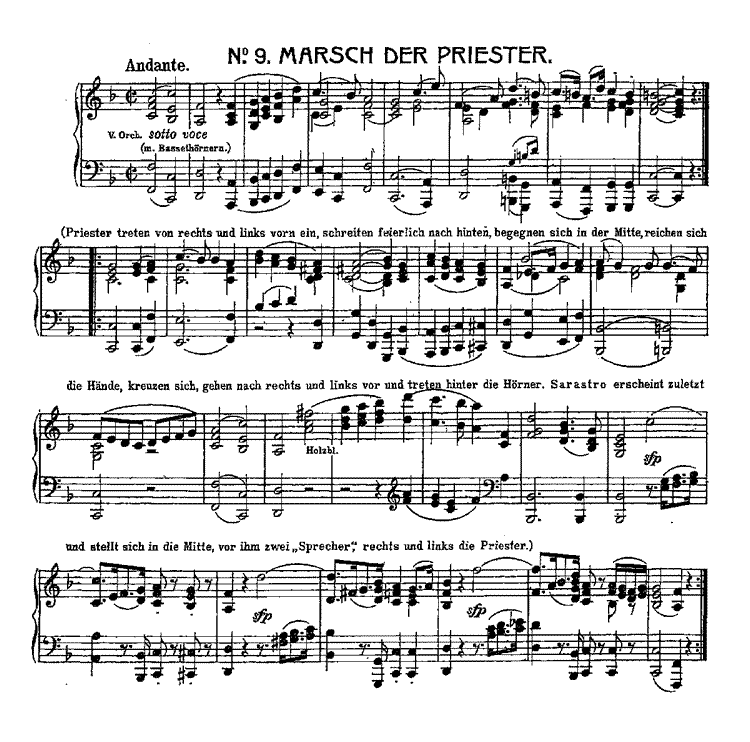
Example 3 lists the musical attributes of the hymn topic as found in Sarastro's processional and in other operatic scenes listed in Example 1. At the far right of the diagram are listed the expressive attributes. The correlations between the musical attributes and expressive attributes are somewhat self-evident for level one. For example, a "voice-like" expression is achieved by chorale texture, rhythmic simplicity, moderate to slow tempo, and sotto voce articulation marking. However, why one should conceive the music as spiritually transcendent or otherworldly is not as obvious. Certainly the chorale texture signals religiosity but not necessarily a transcendent religiosity. More than anything else, it is the opening harmonic gesture of this piece, the I-V7-vi progression, that, when used in combination with the other attributes, imbues the music with a sense of "walking in the spirit." Significantly, nearly every example listed in Example 1 opens with a prominent I-V7-vi progression.4 To further illustrate, Example 4 provides piano reductions of excerpts from the Gluck operas as well as from Mozart's opera Idomeneo. In all cases, vi is heard as the first local melodic and harmonic goal (noncadential). Furthermore, in the excerpts from Iphigénie, Idomeneo, and Die Zauberflöte the arrival of vi is emphasized by its metrical placement on a downbeat. In Die Zauberflöte Mozart magnifies the expressive potential of the I-V7-vi progression by rhythmically isolating it as a self-contained motto.5 I would like now to consider why eighteenth-century opera composers consistently turned to the I-V7-vi progression in the depiction of exalted states of consciousness. What is it about the tonal structure of this progression that allows one to hear it as spiritual?
Example 3.
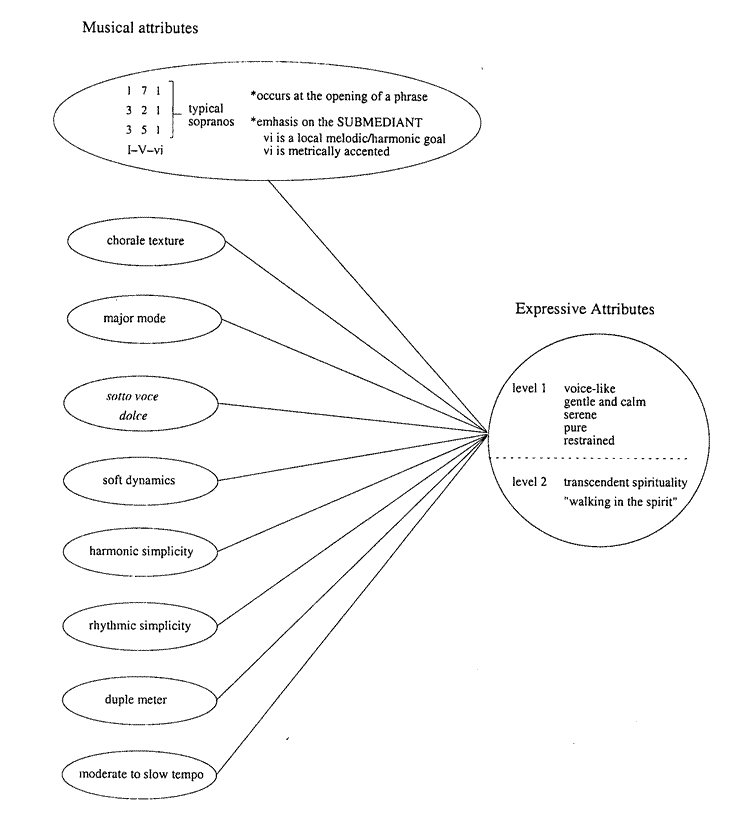
Metaphor theory is particularly useful for my project in that it provides a conceptual framework for mapping the structure of one domain, the source domain, onto the structure of another domain, the target domain. As Mark Johnson argues, the primary source domain that we use to make sense of other domains is our body and more specifically, repeated patterns of bodily experience—what he calls image schemata, such as the ways we move through space, the ways we manipulate objects, or the ways objects or forces manipulate us.6 Image schemata are pre-conceptual experiential gestalts that generate meaning through metaphoric projection. In other words, we make sense of our world by conceptualizing the unfamiliar or abstract in terms of our familiar bodily experience. An important claim that follows, supported by a growing literature of research, is that our understanding and experience of music is mediated and structured by and through our bodies. As I hope to show, the harmonic gesture I-V7-vi is appropriate for the depiction of spirituality because our embodied metaphoric understanding of this gesture is similarly structured to our embodied metaphoric understanding of a "transcendental spiritual state." The structural similarities between the two domains allow one to easily map the domain of spirituality onto the domain of music.
Example 4.
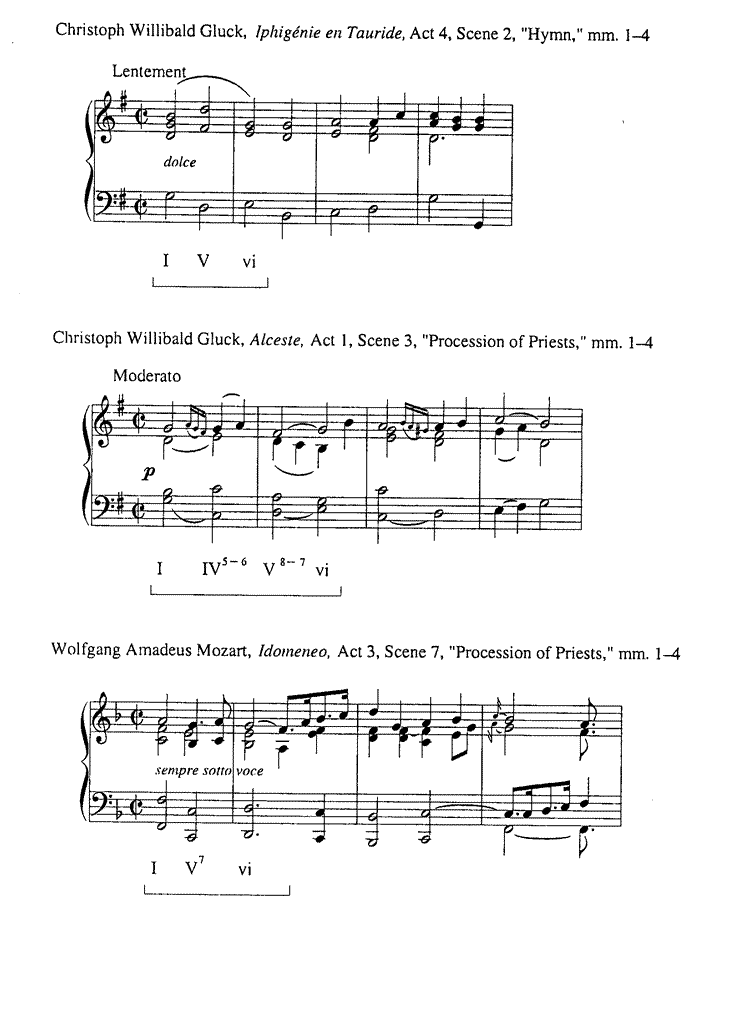
Example 5 presents image schemata derived from our bodily experiences that we routinely map onto musical sound.7 Beneath each image schemata are shown the conceptual metaphors that result from the cross-domain mappings of these schemata onto music. Perhaps the most pervasive and complex metaphor used in describing music is "Music is Motion."8 As Arnie Cox argues, this conceptual metaphor is based on the mapping of "Motion" schema onto changes of states; musical states are understood as locations, change of state is understood as motion between locations, and difference between states is understood as distance between locations.9 It is in this manner, for example, that we perceive a change in pitch frequency between c' and d' as a small musical motion and a change in pitch frequency between c' and d" as a large musical motion. Continuing with the other image schemata, musical motion is plotted on a vertical axis, is subject to the forces of gravity,10 and operates within bounded spaces (containers). Through the mappings of "Motion," "Verticality," "Gravity," and "Container" schemata onto music, we are able to create an imaginary world in which we hear music as a transmutation of physiological impulses—as gesture. Operating within a two-dimensional space, gestures (or the dramatic agent(s) of the gestures) are not only subject to physical forces, but also exert physical forces. It is always important to remind ourselves that the physical qualities we unconsciously map onto music, especially verticality and motion, are products of our imaginations and not intrinsic properties of musical sound. But even though these are not "physical" qualities, they are, nonetheless experientially real and essential properties of our understanding of music.11
Example 5.
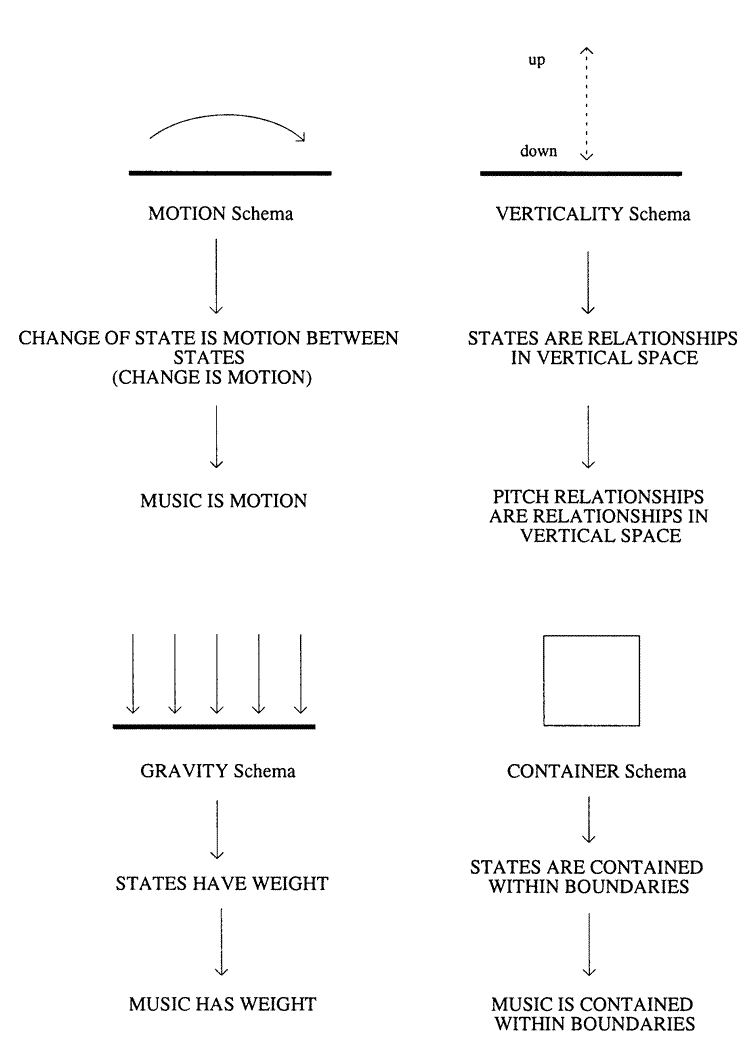
Example 6 provides common metaphoric elaborations, some of which are quite complex, of these conceptual metaphors in conventional descriptive practices of tonal music. While it is beyond the scope of this paper to pursue the cognitive structure and logic these entailments, the example sufficiently shows the fundamental and pervasive role of metaphor in our musical thinking.
Example 6. Elaborations of conceptual metaphors based on musical descriptive practices.
- MUSIC IS MOTION
- ·Music is purposeful motion operating within a field of musical forces, gravity being the most important (others include magnetism, inertia, momentum, propulsion, viscosity, etc.).
- ·Music moves at different speeds/tempos.
- ·Motion follows a path or trajectory with beginning points and goals.
- PITCH RELATIONSHIPS ARE RELATIONSHIPS IN VERTICAL SPACE
- ·Musical pitches, events, and motions are plotted on a vertical axis.
- ·Scale-degree 1 is the Grundton (ground tone), the bottom floor of diatonic pitch space.
- MUSIC IS CONTAINED WITHIN BOUNDARIES
- ·Motion occurs within bounded spaces with beginnings, middles, and ends.
- ·Gestures, motives, phrases, sections, and pieces contain musical content.
- ·Typically, a tonal work will begin in one key and, at some point, modulate out of that key and into another key.
- ·Triads may be prolonged resulting in a prolongational area.
- ·Music and instruments have registral boundaries.
- MUSIC HAS WEIGHT
- ·Tonic is a gravitational field to which other pitches/chords are attracted.
- ·Ascending motion requires more effort than descending motion.
- ·Cadences (from the latin cadere, "to fall") tend to fall into a point of repose.
- ·Lower pitches are heavier than higher pitches.
- ·Meter is a gravitational field in which downbeats attract contextually stable events.
Example 7 illustrates the I-V7-vi progression within a metaphorical space. Much of the expressive impact of this progression stems from the unexpected resolution of the V7 to vi rather than I. Since I-V7-vi is heard as a deviation of I-V7-I, it is helpful first to discuss the "physical" qualities of I-V7-I. Example 7b presents one realization of how the dominant could have resolved. The contrary arpeggiated motion of the outer voices of first two chords implies a continuation in the same direction. The result is a strongly end-weighted progression, a progression Mozart and other Classical composers occasionally employ at a final cadence, though typically within a fuller texture in order to mitigate the indirect octaves between the soprano and bass voice.12 This progression is end-weighted not only by the resolution to a root position tonic with scale-degree one in the soprano and with the bass descending down a fifth to a lower register, but also by the arrival of the tonic on a metrical downbeat. The melody displays a sense of determination by its ascending arpeggiation, which requires physical exertion to overcome the downward force of gravity. The end of the pathway is sharply demarcated by a quarter note rest resulting in a bounded space with a clearly defined beginning, middle, and end. This is an implied and imaginary gesture of physical strength and self-determination. It is also a gesture of worldly convention bordering on the mundane.
Example 7.
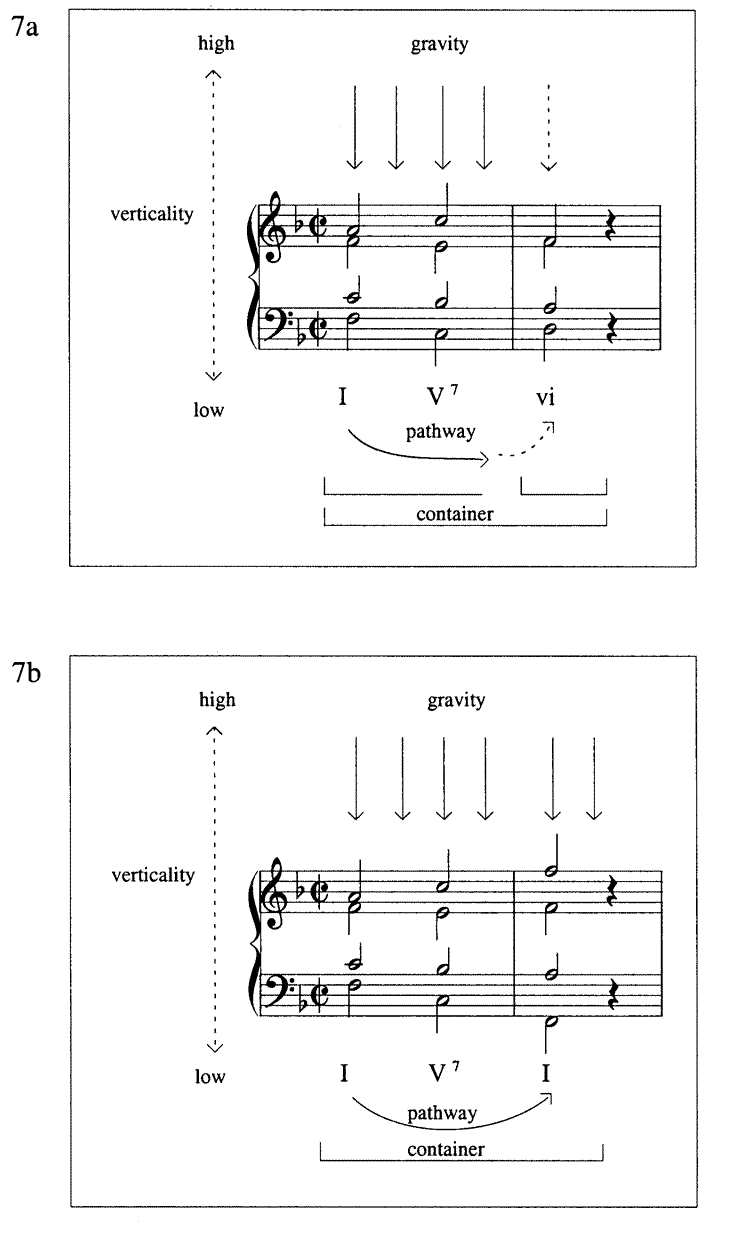
Turning back to Example 7a, the vi creates a discontinuity in the unfolding of the tonal progression. Because the dominant so strongly points toward a tonic resolution, there is less a sense of physical motion toward vi than the unexpected appearance of vi. This discontinuity is most strongly felt in the bass voice with the entrance of scale-degree 6, a pitch not part of the tonic triad. To put it in terms of our active engagement with the music, we do not so much move to the submediant but are rather instantly transported into the submediant pitch space, and through such an act we transcend physical laws of nature. The suddenness of the submediant arrival strengthens its beginning boundary and thus demarcates it as a weakly self-enclosed event within the local grouping structure.
There is a sense of completed pathway, however, with the melody; even though it does not ascend to the high f' as we might expect, it does resolve to scale-degree 1. The lower f' reverses the melodic trajectory of the first two notes and, by falling down a perfect fifth, suggests a sense of collapse and the relinquishing of physical power and exertion. This giving up of one's own effort is typically brought out in performance by a slight subito drop in dynamics on the downbeat of m. 2 accompanied by a break in articulation.13 It is as if one can enter the world of the submediant not by one's own power, merit, or self-will, but only by complete surrender.
As Rudolf Arnheim observes "a tone's place and function within the scale determines its dynamics."14 As shown in Example 8, part of scale-degree 6's uniqueness within the tonal system is that it is the only scale degree that is not a member of either the tonic (I) or dominant chord (V7), and it is one of only three pitches that is not adjacent to a pitch a half-step away. Thus a gravitational (or magnetic) half-step relation does not affect it, nor does it have a well-defined harmonic function. Rather, in its non-directedness it possesses a distinct floating quality. Its expressive quality is more about being rather than becoming. The dominant, on the other hand, is all about becoming. It is keenly future oriented, and the completed I-V7-I progression satisfies our expectations and allows us to move outside our immediate experience of the progression to a birds-eye state of seeing and grasping. The appearance of vi entails an unexpected change of state, from expectant knowing to un-expectant knowing, from future orientation to the eternity of the present tense. While the two common tones vi shares with the tonic gives it a sense of alternative stability, the uncertainty of tonal or melodic direction entails not only a sense of mystery, but also a sense of vulnerability—of not being the one who is in control.
Example 8.
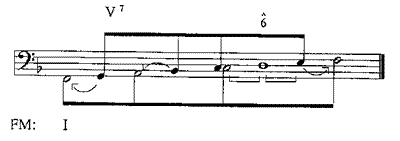
To summarize, the I-V7-vi is heard in expressive opposition to I-V7-I. The implied tonic resolution would create an overtly physical gesture tied to worldly cultural conventions. The sudden reversal of the outward movement to an inward space and a space situated above the conventional tonic resolution space subverts a sense of physicality and of earthly groundedness. The appearance of the bass tone, scale-degree 6, a whole step above the dominant does not entail effort against the forces of gravity, but rather gravity suddenly suspended—this chord exists outside of the conventions of society, outside of the physical forces of gravity, and thereby outside of earthly existence. Example 9 summarizes the expressive oppositions between the progressions I-V7-I and I-V7-vi.15
Example 9. Expressive oppositions.
|
I-V7-I |
I-V7-vi |
The I-V7-vi progression, when used with the other attributes of the hymn topic, is apt in the depiction of spiritual states because its conceptual structure closely correlates to our embodied understanding of exalted states of consciousness. The "Verticality," "Gravity," and "Light" (brightness/darkness) schema are central to our conceptualization of spiritual states and locations. Transcendent spiritual states and locations are elevated; weightless, unaffected by the force of gravity; and bright, radiant, and illuminated. As we have discussed, the vi within the I-V7-vi progression can be heard as elevated and weightless. In the discussion that follows we shall see the musical depiction of brightness in the hands of Beethoven.
The Hymn Topic in Beethoven's Instrumental Music
Once established as a musical sign in opera, the topic of the sacred hymn became available to composers as part of a wider expressive vocabulary of musical topics used in purely instrumental works. Beethoven was one of the earliest composers to make consistent use of this topic. Perhaps the most well-known example is the Heiliger Dankgesang from his late string quartet Op. 132. Example 10 lists the appearances of this topic in both his instrumental and vocal music. The remainder of this article explores Beethoven's use of the sacred hymn in three instrumental works.
Example 10. Instrumental and vocal music by Beethoven that use the chorale topic. In all, the progression I-V7-vi is prominent and in most cases it is used as the opening progression.
Vocal music
|
Lieder von Gellert, "Bitten" |
Op. 48, no. 1 |
EM |
|
Lieder von Gellert, "Vom Tode" |
Op. 48, no. 3 |
F#m |
|
Lieder von Gellert, "Die Ehre Gottes aus der Natur" |
Op. 48, no. 4 |
CM |
|
Lieder von Gellert, "Gottes Macht und Vorsehung" |
Op. 48, no. 5 |
CM |
|
Fidelio, Leonore's Prayer of Hope (Act 1, No. 9) |
Op. 72 |
EM |
|
"Meeres Stille" |
Op.112 |
DM |
|
"Elegischer Gesang" |
Op. 118 |
EM |
|
Symphony No. 9, 4th mvt., Adagio ma non troppo, ma divoto |
Op. 125 |
Gm |
|
"Opferlied" |
WoO 126 |
EM |
|
"Abendlied unterm gestirnten Himmel" |
WoO 150 |
EM |
Instrumental music
|
String Quartet in A Major, 3rd mvt. |
Op. 18, no. 5 |
DM |
|
String Quartet in E Minor, 2nd mvt. |
Op. 59, no. 2 |
EM |
|
String Quartet in Eb Major, 2nd mvt. (Variation 3) |
Op. 127 |
EM |
|
String Quartet in A Minor, 2nd mvt. (Heiliger Dankgesang) |
Op. 132 |
FM |
|
Piano Sonata in C Major, 1st mvt. (second theme) |
Op. 53 |
EM |
|
Piano Sonata in E Major, 3rd mvt. |
Op. 109 |
EM |
|
Piano Concerto No. 3 in C Minor, 2nd mvt. |
Op. 37 |
EM |
|
Piano Concerto No. 4 in G Major, 2nd mvt., mm. 19-26 |
Op. 58 |
DM |
|
Piano Quartet in Eb Major, 1st mvt. |
WoO 36, no. 1 |
E♭M |
|
Seven Variations on "God Save the King" |
WoO 78 |
CM |
Piano Concerto No. 3 in C Minor, Op. 37 (?1800-1803)
Beethoven turns to the topic of the sacred hymn for the opening theme of the second movement of his Piano Concerto in C minor, shown in Example 11. Here, the hymn texture is tempered with a cantabile melody that becomes more elaborate as the music continues. The extempore nature of the melody evokes a sense of individual self expression that suggests hearing the theme as a deeply-personal spiritual song. For Carl Czerny, this theme "must sound like a holy, distant, and celestial Harmony."16 Certainly a sense of distance and otherness is evoked by the soft dynamics and by the extreme remoteness of the key of E major to the key of C minor, the key of the preceding movement. Every pitch in the principal key of C minor is chromatically raised in the new key of E major.17
Although the key of the movement is E major, the only E major triads in the entire opening theme occur in m. 1. As shown by the tonal analysis beneath the score, the music is consumed with celestial V-vi progressions. The theme is segmented into three phrases, each four measures long. The first phrase presents an elaborated I-V7-vi progression in which the submediant is tonicized with its own back-relating dominant. As shown in Example 12, this same basic progression was used just a few years earlier by Joseph Haydn to portray the divine grace of Jesus in the opening vocal music of his oratorio The Seven Last Words of Christ (1795-96).
Example 11.
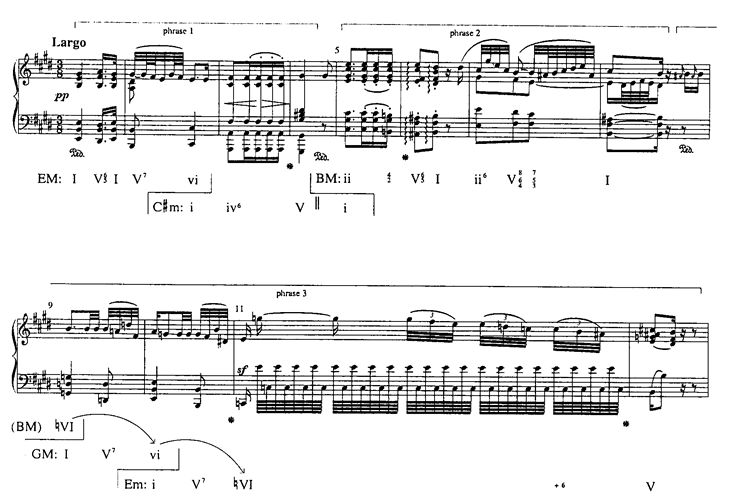
Example 12.
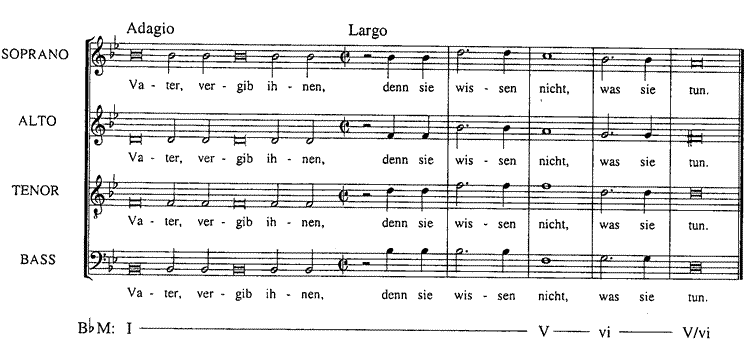
The second phrase begins with the submediant in a higher register, modulates to the dominant, and closes with a perfect authentic cadence. In the third phrase Beethoven launches into a series of chromatic V7-vi progressions that lead to the expressive climax of the passage—a shimmering C major triad, the flat submediant of E major. As the voice-leading sketches given in Example 13 show, at a deeper level the entire theme is governed by the progression I-vi-V-♮-VI-V. Truly remarkable is composing out of the C major triad at the opening of the third phrase. This chord can be thought of as a kind of super-submediant; for not only does the use of mode mixture intensify its identity and function, but each of its chord members are themselves imbued with their own individual sense of submediantness (see Example 11).
Example 13.
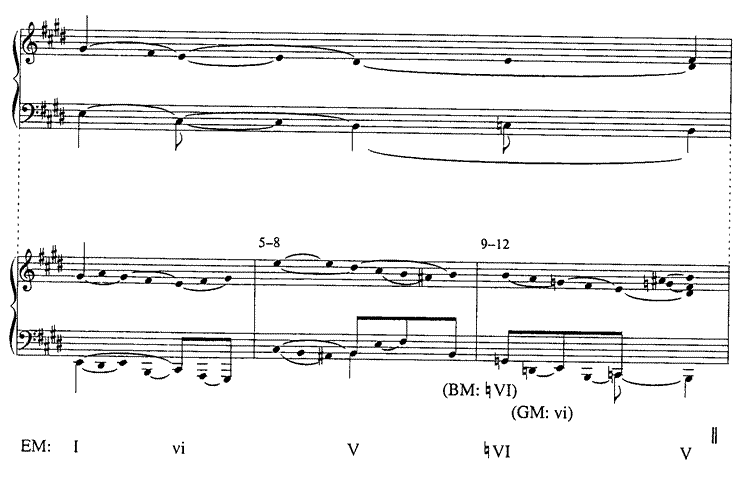
Light
As I previously mentioned, a metaphoric component of a spiritually transcendent state is radiant light, which is defined, in part, by its opposition to darkness. Besides register, timbre, and chord voicings, an important resource in the musical depiction of light is the composer's choice of key. Key characteristics and the source of those characteristics were a central concern of eighteenth- and nineteenth-century composers and theorists.18 In the eighteenth century, key characteristics were generally thought to be a result of unequal temperaments, which produced slight and sometimes not so slight variations amongst the intervals of a key. With the adoption of equal temperament in the early nineteenth century, theorists could no longer cite tuning as the source of key characteristics. Since keys were still felt to possess individual characteristics, theorists sought other explanations. Two explanations were used: the sharp-flat principle and the physical properties of instruments.
The sharp-flat principle, which had been in place since the early eighteenth century, became the most widely accepted explanation of nineteenth-century key characteristics.19 This principle holds that sharp keys or keys higher on the circle of fifths are stronger and brighter than flat keys or keys lower on the circle of fifths, which were considered weaker and darker. Although there were many exceptions, the sharp side generally was thought to reflect the positive in human nature, while the flat side, the negative.
The standard repertoire of keys in the eighteenth and early nineteenth centuries ranged from four flats to four sharps. Without any accidentals, C major was regarded as the purest key and was the point of reference for all other keys. E major was the highest, sharpest, and brightest key in conventional use, while A♭ major was the lowest, flattest, and darkest key. In compositions that depict heaven and spiritually transcendent states, it is thus not surprising to find E major as the preferred key. Conversely, A♭ major (and F minor) were the keys most often used for funeral marches and operatic dungeon scenes. While there was no complete consensus, the majority of late eighteenth- and early nineteenth-century writers, as illustrated in Example 14, describe the expressive quality of E major as bright, uplifting, dazzling, and heavenly.20 A♭ major was viewed as the polar opposite of E major. E major was heard as bright and piercing; yellow was the color often assigned to it. A♭ major, on the other hand, was heard as dark and gloomy; its color was black.
Example 14.
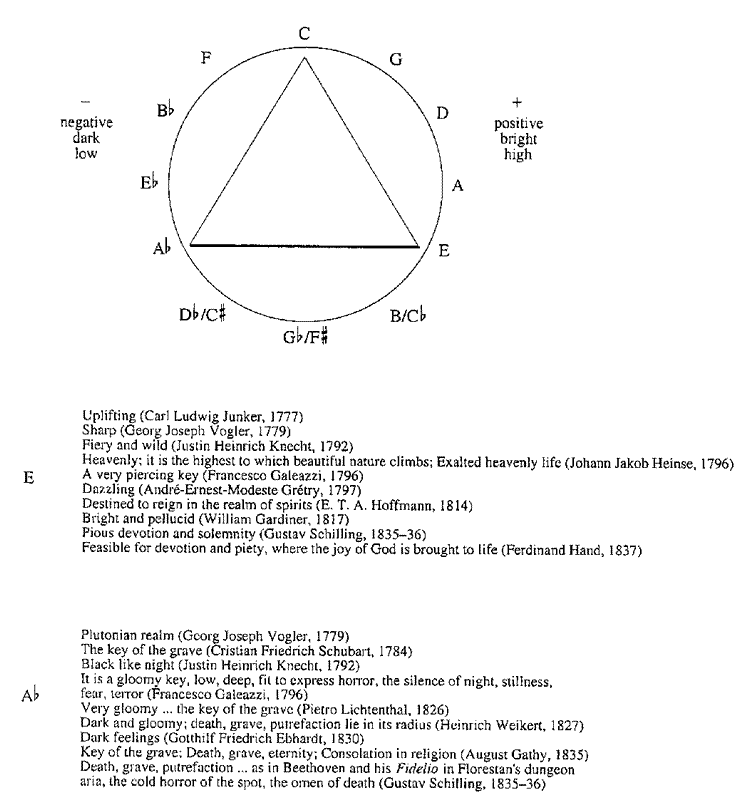
The other explanation for key characteristics is that the physical properties of instruments play a determining role in the particular color and expressive quality of a given key.21 In particular, the violin family was cited as an important source of key characteristics. Keys that used open strings, and especially those whose tonics were one of the open strings, were thought to be brighter, more elevated in character, than those that used stopped strings. One of the most influential sources in the first half of the nineteenth century was an article written by Friedrich Ludwig Bührlen in 1825, published in the Allgemeine musikalische Zeitung in Leipzig. According to Bührlen,
[The] difference in key-colouring is easiest to notice on the violin, and whoever has a half-way practised ear, even if he does not know how to identify the actual key being played, still will feel the conspicuous difference which lies, for example, between the keys of F, A, A♭, E, and E♭ . . . . The sharp keys impart to us their elevated character, the flat keys their depressed character. The frequent use of open strings D, A, and E gives these keys a brighter colour, while on the other hand the repeated, necessarily stopped notes of the flat keys covers the sound as with gauze.22
According to Anton Schindler, Beethoven was convinced, as most were in his time, that keys had individual expressive qualities, and that "to deny without reason the special character of the different keys was to Beethoven like denying the effect of the sun and moon on the ebb and flow of the tides."23 As previously shown in Example 10, E major is the key Beethoven most often uses when he turns to the topic of the sacred hymn. The conventional key characteristics of both E major and Ab major are found in Fidelio. To depict Florestan's utter despair and confinement within a dark and gloomy prison dungeon, Beethoven sets his aria in the keys of F minor and Ab major. In stark contrast, Leonore's first solo aria, a prayer of radiant hope, is set in the key of E major and makes prominent use of the progression V7-vi.24 Beethoven, in this aria and in his other instrumental hymns in E major, is thereby able to musically represent three key elements of a spiritually transcendent state: weightlessness, ascension, and brightness.
Piano Sonata in C Major, Op. 53 (1803-1804)
The first movement of Beethoven's Waldstein Piano Sonata is in C major. The second theme, shown in Example 15, is in the chromatic key of E major, the major mediant of C major. Johann Jakob Heinse in 1795 provides an allegorical account of this key relationship: "the darling major third of C has reached its exalted heavenly life in E major."25
Example 15.
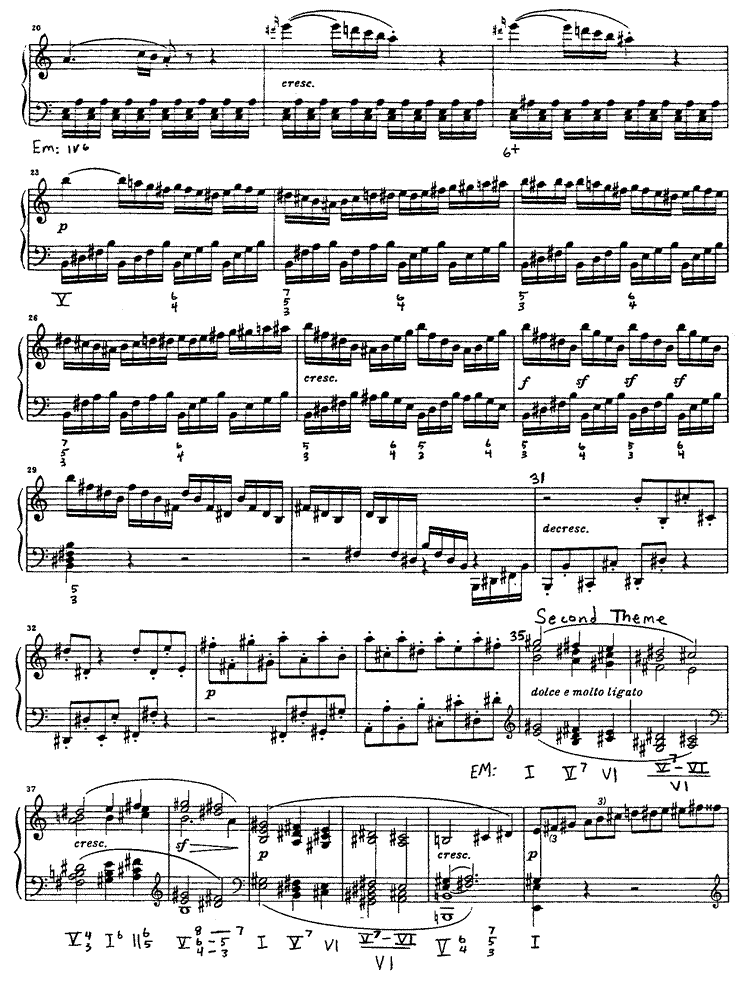
In the Waldstein sonata, the music before the entrance of the second theme creates a context in which to hear and perform the second theme as occupying a "heavenly" space that is both elevated and weightless. The transition section, which begins in m. 18 (not shown), arrives on the dominant of E minor in m. 23. The passage continues with increased speed and momentum to a rhythmically explosive climax in m. 29, after which a six-measure link is needed to release the intense energy in preparation for the entrance of the second theme. Registrally, the piano bottoms out on the downbeat of m. 31. Much like a bouncing ball, the downward impact both motivates and propels a gradual two-octave ascent during which there is a palpable sense of a lessening of gravity, in part, due to the rising line, the decrescendo, and the rhythmic deceleration.26 This gradual release of the earthly force of gravity prepares for the heavenly realm of the second theme. As a musical Jacob's ladder, so to speak, this passage connects the physical realm to the supernatural.
Beginning in m. 35, the articulation marking dolce e molto ligato, the absence of a low bass voice, the soft dynamics, the hymn texture, and the opening I-V7-vi progression all invite the listener to hear this passage as spiritual music, as a sacred hymn. Besides the use of E major, there are several ways the second theme can be conceptualized as bright (as opposed to dark): the high register versus the low register of the first theme; the major mode versus the minor mode; and the consistently doubled thirds of predominantly major triads.
The expressive potential of this interpretation is best realized when the performer slightly relaxes the tempo of the ascent leading into second theme and then holds that tempo for the first statement of the second theme. The slower tempo not only more strongly evokes the sense of a vocal hymn, but also allows the listener to hear more clearly the chord progression, which is operating at a much faster harmonic rhythm than the opening theme. For in the first two bars, Beethoven provides a double take on the I-V7-vi progression. As shown by the harmonic analysis in the score, after the first I-V7-vi progression, Beethoven continues with the same progression in the tonal context of C# minor. Thus, the submediant is tonicized with its own I-V7-VI progression.
The heavenly realm of the second theme is accentuated not only by its approach from the low bass register of the transition, but also by its expressive opposition to the first theme. Example 16 presents a bass-line sketch of mm. 1-38 of the exposition. The opening C major is quickly darkened by mode mixture and by the lament bass in an extremely low register, which slowly descends from scale-degree 1 to scale-degree 5. Above the bass-line sketch I have listed the topics and musical attributes of the first theme, transition, and second theme. In italics, I have listed expressive attributes (more speculative in nature) that creatively amplify the musical and topical reading.
Example 16.
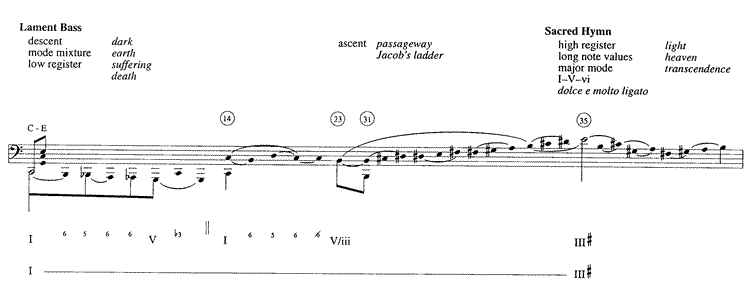
Second Movement of the String Quartet in Eb Major, Op. 127 (1824-1825)
My last example comes from the second movement of Beethoven's String Quartet in Eb Major, Op. 127. Written as a theme and variations, the central variation of this movement, given in Example 17, is perhaps Beethoven's most profound example of the sacred hymn topic.27 Variations in Classical and early Romantic music typically preserve the key of the theme. Breaking this tradition, Beethoven sets the central variation in the key of E major, which, in relation to the overall key of A♭ major, functions as ♭VI, F♭ major. Moreover, the expressive highpoints in this variation are all centered on C chords, which I have boxed in the score. The first, in m. 66, is an augmented 6th chord, and the second two are pure C major triads, the lowered submediant of E major. As in the slow movement of the C-minor Piano Concerto, Beethoven's use of the chromatic submediant, rather than the diatonic submediant, intensifies the music's expressive impact and lends it a greater sense of "otherness." Example 18 shows the nesting of the two submediant relations, which results in a complex of pitches, A♭-E-C.28
Example 17.
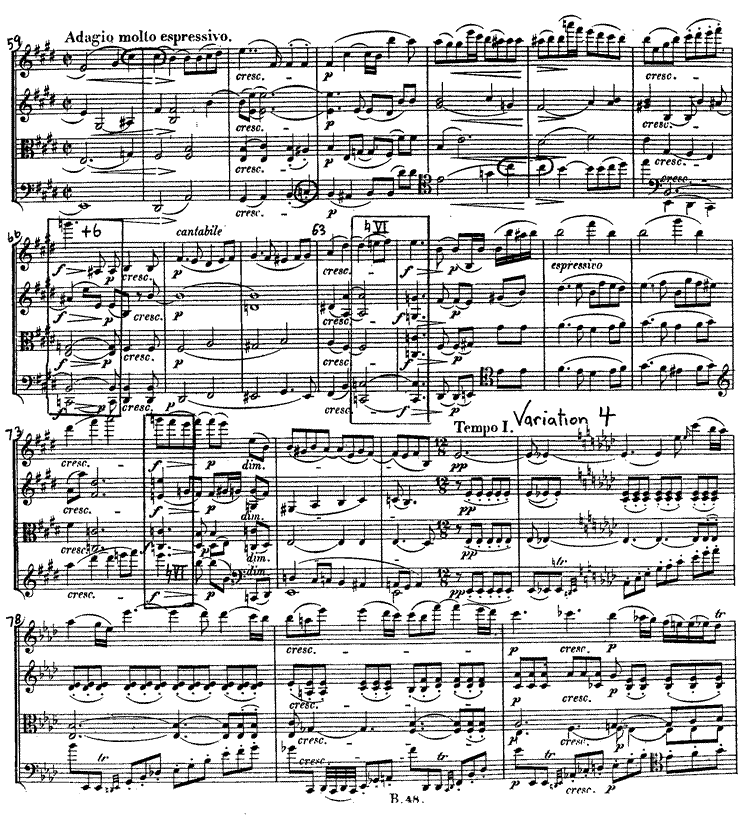
Example 18.
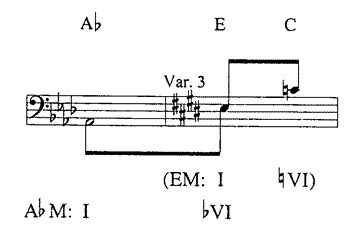
The focus on the submediant, at two levels of tonal organization, in combination with the metrical shift to duple time, the hymn texture, the slow tempo, and legato articulation all combine to lead the listener into a state of spiritual reflection. Indeed, in the preceding music Beethoven has given the listener much to think about. For part of the effectiveness of the expressive impact of the central variation stems from its opposition to the music that surrounds it, in which Beethoven contrasts the heavenly music with earthly music imbued with a strong sense of bodily weight.
Most obviously this is achieved through the preceding dance variation, which not only calls forth the physical motions of a rustic contredanse, but also, through the melodic interplay of the two violins, a scene of physical seduction. Another gravitational force at work is D♭b. Throughout the movement D♭ serves as a force of disruption and imbalance and a force that suggests downward motion.
The downward tug of D♭ is first encountered in the variation's introduction, shown in Example 19. The opening of this movement is an example of a special type of introduction, often employed by Beethoven in his late period, that does not properly "introduce" the material that follows.29 In such cases, the conflict between what is expected and what actually occurs becomes thematic to the movement. First notice that the staggered entrances of the instruments do not support the notated meter at two levels. At the level of the tactus, which is the dotted quarter note, the beat is displaced by one eighth note. And at the metrical level of the measure, the downbeat is displaced by one beat (i.e., one beat too early).
Example 19.

Tonally, the introduction prolongs the V7. Through an unorthodox doubling of the dissonant 7th of the V7, Beethoven both emphasizes and strategically marks the D♭. This doubling, coupled with the delayed entrance of the leading tone, results in an imbalance in the directional pull of the chord: it suggests a continuation that will descend. The music that follows, however, breaks free from the introduction's oppressive weight and wrong meter. Instead of resolving the 7th of the V7 down to scale-degree 3, the first violin ascends, first to A♭, scale-degree 1, and then to F, scale-degree 6, the submediant. The act of breaking free, of transcending one's physical boundaries, and the arrival on the submediant, set the stage for the central variations.
Example 20 provides an expressive interpretation of the entire movement. In this reading, the music progresses between various states of human existence. The first three sections progress from earthly introspection of the mind, to the dancing body, and finally to a state of spiritual reflection. The recapitulatory fourth section and coda provide a reconciliation of these three different states.
Example 20. Expressive form of the second movement of Beethoven's String Quartet in E♭ Major, Op. 127
|
Theme Variation 1 |
Variation 2 |
Variation 3 |
Variation 4 Variation 5 |
Coda |
|
Mind |
Body |
Spirit |
Reconciliation between Mind and Body |
Reconciliation between Mind, Body and Spirit |
|
Earthly introspection |
Dance |
Hymn |
"Recapitulation" |
|
|
A♭M |
|
A♭M |
EM |
A♭M |
|
12/8 |
|
4/4 |
2/2 |
12/8 |
The theme and first variation are unified by meter, texture, dynamics, and by the process of gradual individualization of the four voices.30 The music is introspective and conceptually difficult. The adagio 12/8 meter demands greater memory from the listener in order to keep track of the four pulses within the measure. Adding to the difficulty, the first two phrases offer no consistent rhythmic pattern in the accompaniment, nor any standard pattern of motivic repetition.
While the theme can be viewed as difficult, especially in terms of what one would expect from a typical variation theme, the first variation increases the musical complexities to the point of entering the realm of the esoteric. The theme is shattered and reassembled into a splintered musical landscape that freely develops fragments of the theme. The texture continuously and unpredictably shifts emphases to and from different voices and groups of voices. The music is marked by disjunction, metrical ambiguity, and harmonic complexity. It is as if it was Beethoven's intent to perplex the listener, for in a standard variation there is typically some organizational connection between a theme and variation, especially the first variation. Here there is none.
The music takes a sudden turn to the physical realm in Variation 2, a rustic contredanse in duple time. Here a clear and simple accompaniment pattern provides the necessary rhythm to support the bodily motions of a dancing couple, as represented by the two violins. At the point of greatest social intimacy, that is, when, in mm. 47-48, the two violins come together in parallel thirds and sixths, the music dives into the loudest, most intense and extroverted climax of the movement (m. 49), a climax that results in a two-bar expansion of the phrase. The dramatic force of the climactic passage is highlighted by the move to D♭ minor, the minor subdominant of A♭ major, and by the unison texture in the lower three voices. The wild command of D♭ minor disrupts the dance and produces a moment of total abandon. Adding to the untamed quality of this passage is that the unison texture has absolutely no syntactical value.31 That is, it does not lead to or highlight a structural junction in the music as it typically does in Classical and early Romantic music. In m. 52, the dance resumes as if nothing happened, restoring a sense of equilibrium.
The passage into Variation 3, the sacred hymn, is as abrupt as it is profound. At the conclusion of the dance on the last beat of m. 58 the music again turns to the minor subdominant, notated as C# minor. In unison texture, which recalls the Db minor outburst in the dance, the music arpeggiates to the third of the chord, E. In an act of amazing grace, both physical and spiritual, the third of the minor subdominant is sublimated into the tonic of E major. Slowly, and now within the context of a hymn, the melody in the first three bars of the third variation unfolds an E major triad, establishing it as a new tonic.
As previously noted, while the music is notated in E major, the functional key is F♭ major, the lowered submediant of A♭ major. The key of F♭ major was, in common practice, never used as an overall tonic; occasionally, though, it can be found as a secondary key within a movement. But even though one can easily understand the relationship between Ab major and Fb major as a product of mixture, the sense of E major looms large.
There are several reasons why it makes sense to hear the music as E major. First, Beethoven notated it in E major and as a consequence it is performed as if it were in E major. Second, because of the physical properties of the violin family, acoustically it sounds like E major. And as Bürhlen remarks, anyone with "a half-practiced ear" can recognize the piercing quality of an open E string. So individual a sound it is, that it is very difficult to think of it as being anything else but an E. But as Example 10 shows, and as William Kinderman has observed, perhaps the most persuasive reason is that Beethoven himself closely associates the key of E major with spirituality.32
Returning to the introduction of the variation movement, one sees how well contemporary descriptions of Ab major correspond with the music. All four instruments play on their lowest strings using stopped notes. The low muted register coupled with the unusual doubling of the 7th gives the music a sense of depth, darkness, and gravity.
In the theme and first two variations, Beethoven reinforces the veiled sonority of stopped strings by his dynamic markings, which, except for the D♭ minor outburst in the dance, never rise above a piano level. To achieve this in performance requires the musicians to position their bows away from the bridge at a point where the sound contains fewer overtones and is thus more muted. The E major spiritual hymn, by contrast, makes use of open strings and crescendos to a forte three times, two times climaxing on a C major chord, the flat submediant of E major. C major as a functional harmony not only magnifies the topic of spirituality, but as an acoustical event, the C major chord in m. 64 is the most resonant chord in the entire movement and of the entire quartet.
Is the central variation in E major or F♭ major? To say it is definitely one or the other limits the richness of the music's communicative powers. Syntactically, the variation is in F♭ major; Beethoven enters and departs the central variation by means of common-chord modulation and thereby gives the listener the means to hear its functional relationship to A♭ major as ♭VI. Semantically, however, by its association with a family of spiritual music and by the unique timbral quality of the violin family, it is in E major. Beethoven brings together three compositional techniques that signal spirituality: the prominence of the submediant on two levels of tonal structure, the associative use of E major in opposition to A♭ major, and the topic of the sacred hymn.
Joseph Kerman and William Kinderman have commented upon the recapitulatory nature of the fourth variation.33 The original key and meter is restored and there is a recognizable restatement of the melody, first in the violin and then answered in the cello. The crucial difference is that the theme's serpentine melody is now metrically grounded by a rhythmically stable accompaniment pattern. Elements of the dance from the third variation appear in the turn figures, first in the cello and then in the first violin. The fifth variation also maintains a consistent accompaniment pattern with the melody now rhythmically accelerated into a constant stream of sixteenth notes. Variations 4 and 5 thus form a pair by their recapitulatory nature and by their reconciliation of melodic complexity with rhythmic and metrical clarity, or, in terms of human states, a reconciliation between the mind and the body.
The last variation breaks off in m. 118—a measure early—on a cadential dominant. The remaining nine measures, a coda, prolong the dominant until its final resolution in the last measure of the work. During the course of the dominant prolongation, elements of the first three sections merge in a reconciliation of mind, body, and spirit. After two bars of a pulsating accompaniment and melodic references to the dance, the music melts into the introspective texture of the opening variation theme. The music continues to another cadential dominant in m. 121, which resolves deceptively into a Db minor triad, the minor subdominant and, within the context of the movement, an agent of imbalance, turmoil, and disruption. D♭ minor triad is set, however, within a hymn texture, and, in the next measure, is transformed into a glistening E major chord. The coda concludes with a motivic reference in the first violin to the very opening of the movement. After reiterating scale-degree 4, the seventh of the V7, the violin's melody turns upwards and slowly ascends by step to its final resting place, scale-degree 1.
While previous commentators, including, apparently, Beethoven himself, have often noted the spiritual nature of the music I have discussed or referred to, little attention has been given to exactly why this music should be heard as spiritual or its relationship to the topic of the sacred hymn.34 We have seen how Beethoven not only uses the topic of the sacred hymn but also creatively develops it in interesting ways. Three things stand out: first, his preference for the key of E major in the depiction of spiritual states; second, his expanded treatment of the submediant at both small and large-scale levels of tonal organization; and third, Beethoven's use of the hymn topic within an expressive interplay of other musical topics in which the topic of the sacred hymn is set in opposition to music depicting our earthly condition. And finally, I hope I have shown how a fuller understanding of the topical discourse of Beethoven's time, and specifically the topic of the spiritual hymn, can provide the listener and performer a richer conceptual framework from which to draw potential musical interpretations. In understanding the bodily basis of these interpretations, one can more easily move in and between analysis and performance.
List of References
Arnheim, Rudolf. "Perceptual Dynamics in Musical Expression." The Musical Quarterly 70, no. 3 (1984): 295-309.
Anson-Cartwright, Mark. "Opening Motions to the Submediant in Mozart." Paper read at the annual meeting of the Music Theory Society of New York State, April 2006, at Skidmore College, Saratoga Springs.
Bribitzer-Stull, Matthew. "The Ab-C-E Complex: The Origin and Function of Chromatic Major Third Collections in Nineteenth-Century Music." Music Theory Spectrum 28, no. 2 (2006): 167-90.
Brower, Candace. "A Cognitive Theory of Musical Meaning." Journal of Music Theory 44, no. 2 (2000): 323-79.
Carpenter, Patricia. "The Musical Object." Current Musicology 5 (1967): 56-87.
Cox, Arnie. "Where Musical Places Come From: The Conceptual Metaphor STATES ARE LOCATIONS." Paper read at the annual meeting of the Society for Music Theory, November 2000, Toronto.
Czerny, Carl. On the Proper Performance of All of Beethoven's Works for Piano. (1846) Edited with a commentary by Paul Badura-Skoda. Vienna: Universal Edition, 1970.
Guck, Marion. "Musical Images as Musical Thoughts: The Contribution of Imagery to Analysis." In Theory Only 5 (1980): 29-43.
______. "Two Types of Metaphoric Transference." In Music and Meaning, edited by Jenefer Robinson, 201-16. Ithaca: Cornell University Press, 1997.
Hatten, Robert S. Musical Meaning in Beethoven: Markedness, Correlation, and Interpretation. Bloomington: Indiana University Press, 1997.
Johnson, Mark. The Body and the Mind: The Bodily Basis of Meaning. Chicago: University of Chicago Press, 1987.
Kerman, Joseph. The Beethoven Quartets. New York: W.W. Norton, 1966.
Kinderman, William. Beethoven. Berkeley: University of California Press, 1995.
Larson, Steve. "Musical Forces and Melodic Patterns." Theory and Practice 22 (1997): 55-72.
______. "Musical Forces, Melodic Expectation, and Jazz Melody." Music Perception 19, no. 3 (2002): 351-85.
______."Musical Forces and Melodic Expectations: Comparing Computer Models and Experimental Results." Music Perception 21, no. 4 (2004): 457-98.
Levy, Janet. "Texture as a Sign in Classic and Early Romantic Music." Journal of the American Musicological Society 35, no. 3 (1982): 482-531.
Lockhead, Judy. "The Metaphor of Musical Motion: Is There an Alternative?" Theory and Practice 14-15 (1988-89): 83-103.
McKee, Eric. "Alternative Meanings in the First Movement of Beethoven's String Quart- et in Eb Major, Op. 127: Emergence and Growth from Stagnation and Decline." Theory and Practice 24, no. 2 (1999): 237-62.
Monelle, Raymond. The Sense of Music: Semiotic Essays. Princeton: Princeton Uni- versity Press, 2000.
Endnotes
1I am grateful to Arnie Cox for reading an earlier version of this article and providing helpful suggestions.
2A topic can be defined as a cultural musical code (iconic and/or indexical) that would have been readily identifiable by contemporary listeners in terms of its various stylistic or generic traits. Topics include dance types, such as the minuet, sarabande, march, and waltz, or general styles, such as hunt music, Turkish music, or the French overture. I know of no published research that specifically focuses on the topic of the sacred hymn. My general notion of "topic" is drawn from Ratner, Classic Music; Hatten, Musical Meaning in Beethoven; and Raymond Monelle, The Sense of Music.
3Johnson, The Body in the Mind. For the most recent and comprehensive treatment of metaphor in music, see Zbikowski, Conceptualizing Music and Spitzer, Metaphor and Musical Thought.
4For a study of the melodic features of the I-V7-vi progression in the music of Mozart, see Anson-Cartwright, "Opening Motions to the Submediant in Mozart."
5The progression V-vi, in various tonal contexts, reappears throughout the march.
6Johnson, The Body in the Mind, 18-40.
7Example 5 only lists the most prevalent schemata that we use in listening to music. Moreover, each of these four schemata can be combined and/or elaborated. See Brower, "A Cognitive Theory of Musical Meaning," 323-72, for a more comprehensive account of the role of image schemata in the creation of musical meaning. Although Johnson makes use of visual diagrams to represent image schemata, he cautions that such diagrams only capture the key structural features and internal relations of image schemata. By definition, a concrete diagram cannot represent a pre-conceptual cognitive activity. See Johnson, The Body in the Mind, 23-28 and Zbikowski, "Conceptual Models and Cross Domain Mappings," 219.
8For discussions of "music as motion," see Zuckerkandl, Sound and Symbol, 74-48; Carpenter, "The Musical Object," 56-87; Marion Guck, "Musical Images as Musical Thoughts," 29-43; Judy Lockhead, "The Metaphor of Musical Motion," 83-103; and Arnie Cox, "Where Musical Places Come From."
9Arnie Cox, "Where Musical Places Come From."
10As gravity is the most pervasive force in everyday experience, it is also the most pervasive musical force. On the role of gravity in the creation of musical meaning, see Arnheim, "Perceptual Dynamics in Musical Expression," 295-309 and Candace Brower, "A Cognitive Theory of Musical Meaning," 334-38. Steve Larson provides the most comprehensive study to date of musical forces. See "Musical Forces and Melodic Patterns," 55-71; "Musical Forces, Melodic Expectation, and Jazz Melody," 351-85; and "Musical Forces and Melodic Expectations," 457-98,
11Marion Guck uses the term "music-literal" for metaphorical concepts so pervasive as to be perceived as real. See Marion Guck, "Two Types of Metaphoric Transference," 201-16.
12A version of this implied progression occurs near the very end of the opera. After the Queen of the Night is defeated and cast into eternal damnation, Sarastro victoriously declares: "the suns radiant glory has vanquished the night, the powers of darkness have yielded to the light." The music then bursts into a celebratory Allegro, dance-like in character. Harmonizing an upwardly arpeggiating melody, 3-5-1, the progression I-V6-vi is used to signal a spiritual victory of good over evil.
13See, for example, Nikolaus Harnoncourt's 2000 recording (Teldec 242716-2).
14Arnheim, "Perceptual Dynamics in Musical Expression," 301.
15Concerning the concept of expressive opposition, see Robert Hatten, Musical Meaning in Beethoven, 70-82.
16Czerny, On the Proper Performance, 98.
17William Kinderman remarks that this tonal relationship "contributes, along with many details of texture and orchestration, to the magical shift to a brighter tonal colour that sets the Largo apart from the framing movements." Kinderman, Beethoven, 68. Czerny's observation about the sense of distance was perhaps also motivated by his memory of Beethoven's first performance of the concerto in April 1803, during which, according Czerny, Beethoven held the sustain pedal down during the entire theme. Czerny, On the Proper Performance, 97.
18Much of my discussion of key characteristics is based on the work of Rita Steblin. See Steblin, A History of Key Characteristics.
19Ibid., 96-128.
20The quotes given in Example 14 are taken from Steblin, A History of Key Characteristics.
21Steblin, A History of Key Characteristics, 129-45.
22Quoted in Steblin, Key Characteristics, 135.
23Schindler, Beethoven as I Knew Him, 369.
24For another example of "Ab major as dark," see Beethoven's song "In questa tomba oscura" [In this dark tomb].
25Quoted in Steblin, A History of Key Characteristics, 108. In his recording of this sonata (Deutsche Grammophone 427 642-2), Maurizio Pollini beautifully foreshadows the large-scale move from C major to E major in his subtle voicing of the opening C major chord. At the very outset he emphasizes the low Cs, after which he gradually brings out the upper-voice E. The result is that the chord appears to emerge from its fundamental to its third.
26This passage is unusual in that rising lines typically elicit a sense of greater tension and effort than descending lines, which is in part due to the listener's metaphoric projection gravity onto the music.
27Joseph Kerman observes that the central variation's "decided tone of prayer makes a spiritual crown for the movement, and for that matter, the quartet as a whole." Kerman, The Beethoven Quartets, 216.
28For a recent study of the Ab-C-E complex in nineteenth-century music, see Bribitzer-Stull, "The Ab-C-E Complex."
29The first movement of Op. 127 contains an excellent example of this type of introduction. See McKee, "Alternative Meanings."
30To follow the discussion, the reader may wish to consult a complete score of this movement.
31For a discussion on the expressive and syntactical role of unison texture, see Levy, "Texture as a Sign," 482-531.
32Kinderman, Beethoven, 288.
33Kerman, The Beethoven Quartets, 217 and Kinderman, Beethoven, 287.
34According to Carl Czerny, Beethoven conceived the slow movement from Op. 59, no. 2 "while contemplating the starry heavens and thinking of the music of the spheres." The hymn-like music is set in EM and opens with a I-V7-vi progression. Quoted in Thayer, Life of Beethoven, 408-9.


